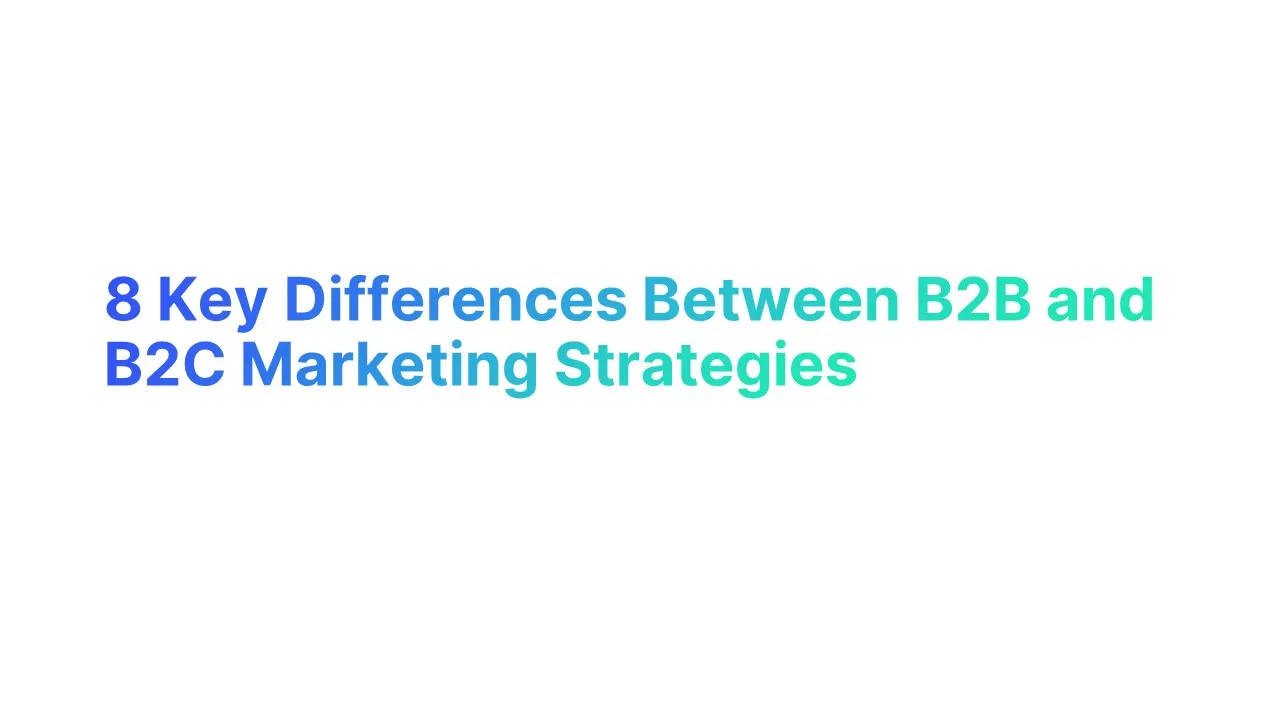Introduction to B2B and B2C Marketing
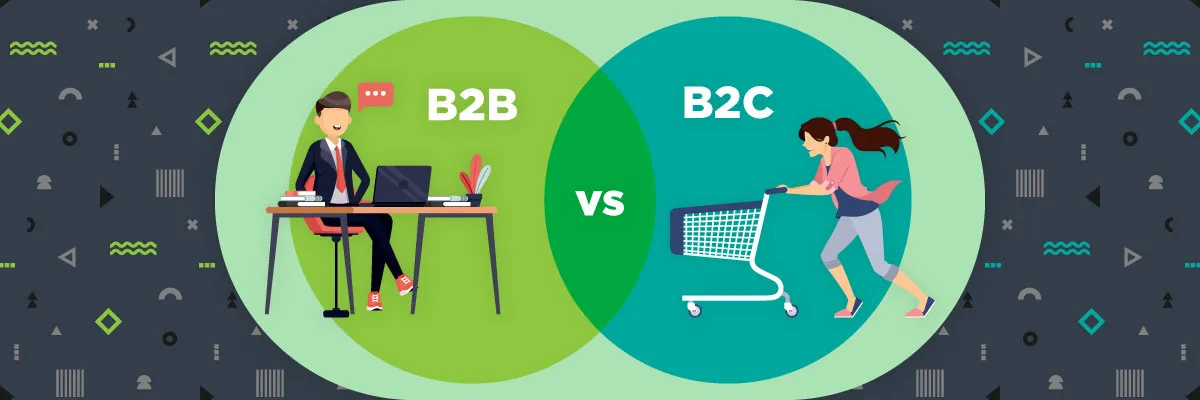
What is B2B (Business-to-Business) Marketing
B2B (Business-to-Business) marketing focuses on strategies and tactics that companies use to sell their products or services to other businesses.
B2B Marketing Involves
1. Relationship-building
B2B marketing strategies prioritize building long-term relationships. It's about establishing trust and credibility.
- A software company may offer free webinars and detailed eBooks to educate their prospects about the product's benefits in streamlining operations.
2. Complex decision-making process
Purchasing decisions often involve multiple stakeholders and a longer sales cycle.
- 74% of B2B buyers report researching at least half of their work purchases online before making a decision.
3. Content Marketing
Providing valuable content that addresses specific industry issues is crucial.
- It helps in positioning the company as a thought leader, which is pivotal in a market where decisions are heavily researched.

What is B2C (Business-to-Consumer) Marketing
B2C (Business-to-Consumer) marketing targets individual consumers who are making personal buying decisions.
B2C Marketing Involves
1. Emotion-driven purchasing
B2C strategies often leverage emotions to provoke immediate responses.
- A clothing retailer may use vibrant imagery and engaging stories in their campaigns to appeal to consumers' desires for a new fashion look.
2. Simplified buying process
The journey from discovery to purchase is usually shorter, with fewer steps.
- On average, 65% of B2C customers make a purchase the same day they start researching a product.
3. Social Media and Influencer Marketing
Utilizing influencers and social media platforms to reach a larger audience is common.
- With 72% of B2C marketers using these channels, they've proven effective in building brand awareness and driving sales through relatable content.
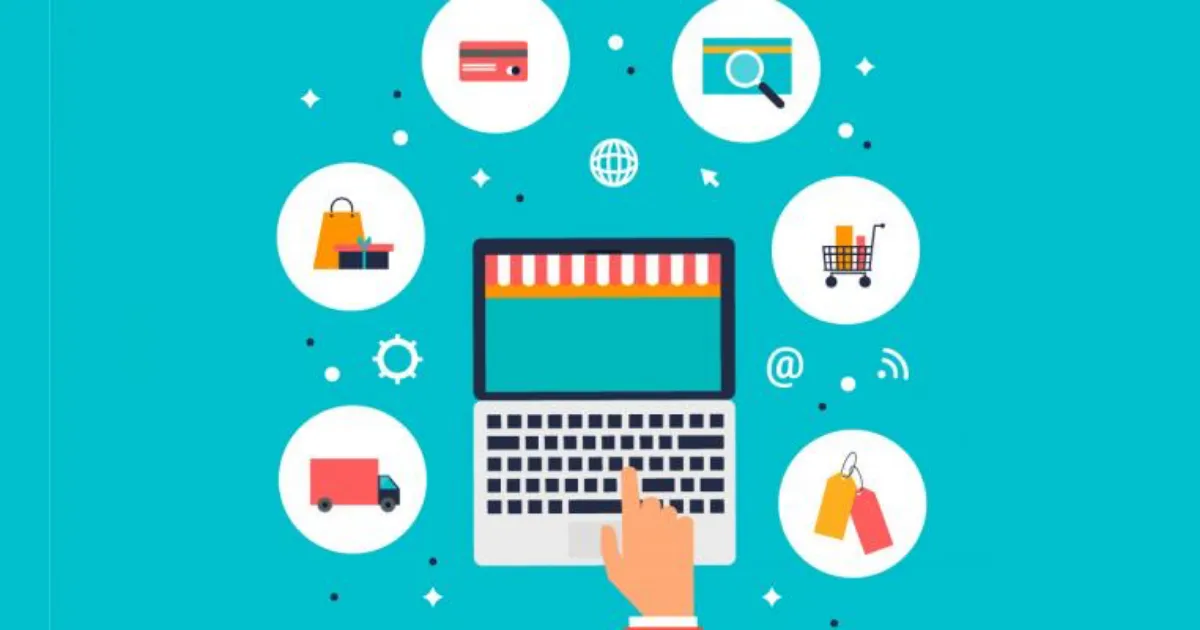
Key Differences Between B2B and B2C Marketing
B2B vs B2C Marketing Strategy: Buying Cycle Length
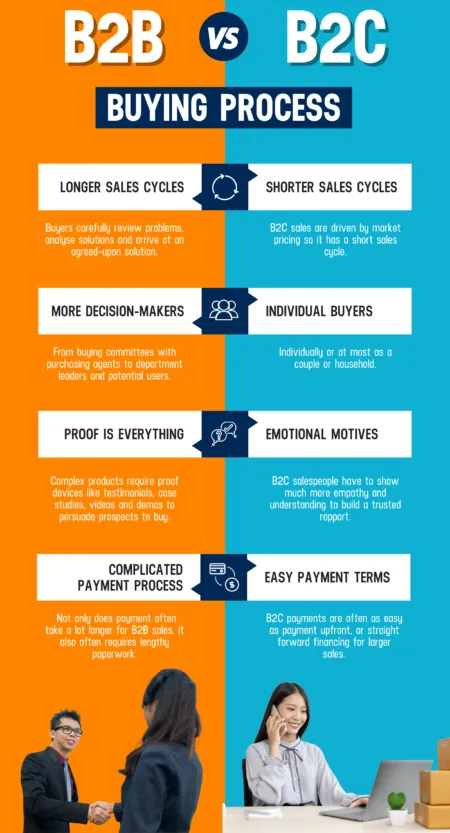
The length of the buying cycle—spanning from awareness to consideration to decision—varies significantly between B2B and B2C markets, reflecting the complexity of purchase decisions and the nature of the purchasing entities.
This variance has profound implications for marketing strategies, necessitating adjustments in tactics, messaging, and engagement to align with the temporal dynamics of each cycle.
B2B Buying Cycle:
Longer and More Complex: The B2B buying cycle is typically longer, often spanning weeks, months, or even years. This extended cycle is due to the complexity of B2B products and services, the significant investment involved, and the need for buy-in from multiple stakeholders within the purchasing organization.
- Example: A company considering a new enterprise resource planning (ERP) system may spend months or even years evaluating different vendors, undergoing product demos, and securing approvals from various department heads.
Strategic Nurturing Required: Given the length of the B2B buying cycle, marketing strategies must focus on long-term engagement and nurturing. This involves providing valuable content at each stage of the cycle, maintaining open lines of communication, and gradually building a compelling case for the purchase.
- The goal is to stay top-of-mind and build a relationship of trust and authority with potential buyers, guiding them through the decision-making process with relevant information and support.
B2C Buying Cycle:
Shorter and More Direct: In contrast, the B2C buying cycle is typically much shorter, often concluding within a single session of online browsing. Purchases are driven by personal need or desire, with fewer layers of approval and consideration required.
- Example: A consumer might see an ad for a pair of sneakers on social media, click through to the product page, and complete the purchase within a few minutes or hours.
- Impulse purchases account for a significant portion of B2C transactions, with a study from The Checkout revealing that 50% of all purchases in retail are unplanned.
Focus on Immediate Conversion: B2C marketing strategies are optimized for quick conversions, leveraging compelling calls-to-action, limited-time offers, and seamless purchasing experiences to encourage immediate decision-making.
- The immediacy of the need and the lower relative cost of individual purchases make speed and convenience paramount. Marketing efforts are designed to minimize friction and capitalize on spontaneous purchasing behaviors.
B2B vs B2C Marketing Strategy: Digital Marketing Approaches

The selection and optimization of communication channels are pivotal elements in the marketing strategies of both B2B and B2C businesses.
These channels are the conduits through which companies engage their audience, share their value proposition, and build customer relationships.
B2B Communication Channels:
Professional Networks and Platforms: B2B marketers prioritize channels that allow for detailed, informative communication and networking within professional communities. LinkedIn, industry-specific forums, and webinars are key platforms for engaging with business audiences.
- Example: A B2B technology firm might leverage LinkedIn to share thought leadership articles, participate in industry discussions, and host webinars on tech trends affecting specific sectors.
Email Marketing: Personalized and segmented email campaigns are a cornerstone of B2B communication, used to nurture leads, share industry insights, and keep in touch with existing business buyers
- Email allows for direct, personalized communication with prospects and customers, delivering content that addresses their specific needs and stages in the buying cycle.
B2C Communication Channels:
Social Media and Influencer Marketing: B2C brands extensively use social media platforms like Instagram, Facebook, and TikTok to reach a broad consumer audience. Influencer partnerships further amplify their message, leveraging the trust and engagement influencers have with their followers which influence the purchase decision for buyers
- Example: A fashion brand might collaborate with influencers on Instagram to showcase their clothing, tapping into the influencers' audience and creating visually engaging content that drives brand awareness, sales and financial incentive
Online Advertising and SEO: B2C marketers invest in search engine optimization (SEO) and online advertising (including PPC and display ads) to capture consumer attention at various stages of the digital journey. These channels help in driving website traffic, increasing brand visibility, and converting interest into sales.
- With consumers increasingly turning to search engines to research and make purchase decisions, being visible on these platforms is crucial for B2C brands to attract and engage potential customers.
B2B vs B2C Marketing Strategy: Customer Relationships
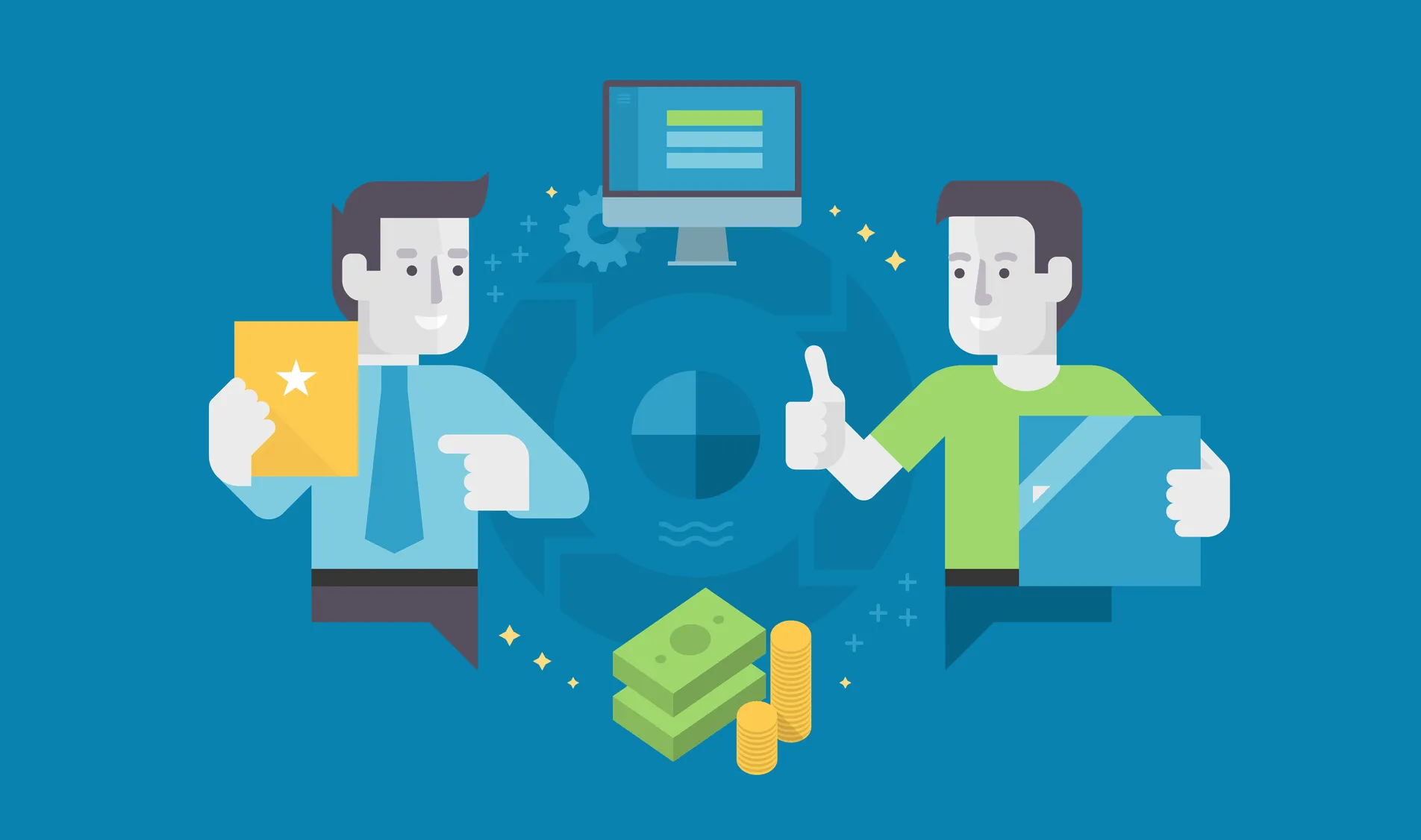
The nature of the relationship, the communication channels used, and the strategies for engagement vary greatly, reflecting the different expectations and needs of the two markets.
B2B Customer Relationships:
Long-term and Consultative: B2B relationships are characterized by their long-term focus and consultative nature. The aim is to build a partnership based on trust, reliability, and mutual benefit. B2B marketing strategies often involve account-based marketing, personalized communications, and ongoing support to nurture these relationships.
- Example: A B2B software provider may assign account managers to each client, offering regular check-ins, customized support, and updates tailored to their specific business needs.
Focused on Problem-Solving: The foundation of B2B customer relationships is the ability to understand and address the unique challenges and needs of each business client. This involves a deep dive into the client’s industry, business model, and operational challenges.
- B2B buyers are looking for solutions that will improve their operations, enhance efficiency, or drive growth. Demonstrating an understanding of their specific issues and providing tailored solutions is key to strengthening the relationship.
B2C Customer Relationships:
Transactional and Emotion-driven: B2C relationships tend to be more transactional and driven by emotional connections. While repeat business is important, the focus is on creating a positive, memorable buying experience that encourages loyalty and word-of-mouth referrals. B2C marketing strategies leverage branding, customer service, and loyalty programs to build these connections.
- Example: A consumer electronics retailer might use social media to engage customers with tech tips, new product announcements, and special offers, fostering a sense of community and brand loyalty.
- According to a study by Emarsys, 80% of customers are more likely to purchase from a brand that provides personalized experiences.
Wide-reaching and Engaging: B2C marketing strategies prioritize reaching a broad audience through engaging content, advertising, and promotions. The emphasis is on simplicity, accessibility, and creating an appealing narrative around the brand and its products.
- With a wider and more diverse customer base, B2C brands focus on casting a wide net to attract as many customers as possible, using engaging and relatable content to draw them in.
B2B vs B2C Marketing Strategy: Branding and Positioning

Branding and positioning are central to both B2B and B2C marketing strategies, serving as the foundation for how businesses communicate their unique value to their target audiences.
B2B Branding and Positioning
Authority and Trust: B2B branding focuses on establishing authority and trust within the industry. The goal is to position the brand as a thought leader and a reliable partner that understands and can solve the complex challenges faced by its business customers.
- Example: A B2B company specializing in cybersecurity might produce in-depth whitepapers, case studies, and host webinars to demonstrate its expertise and the robustness of its solutions.
- According to a LinkedIn study, 53% of B2B buyers stated that trustworthiness is the most important factor when selecting a vendor.
Customized Solutions: Positioning in the B2B arena often revolves around the ability to offer tailored, scalable solutions that meet the specific needs of different industries or customer segments. Emphasis is placed on customization and adaptability.
- B2B purchasers are looking for products or services that can seamlessly integrate into their existing operations and provide solutions to their unique problems, making the ability to customize a key differentiating factor.
B2C Branding and Positioning
Emotional Connection and Lifestyle: B2C branding aims to create an emotional connection with consumers, positioning the brand as an integral part of the consumer's lifestyle or personal identity. This involves storytelling, aspirational messaging, and highlighting the experiential benefits of the product or service.
- Example: A fashion brand might position itself as not just selling clothes but selling a lifestyle of elegance and confidence, leveraging social media influencers and visually compelling campaigns.
- A study by Harvard Business Review found that emotionally connected customers are more than twice as valuable as highly satisfied customers, in terms of brand loyalty and spending.
Broad Appeal and Accessibility: B2C brands typically strive for a broad appeal, making their products or services accessible and appealing to a wide demographic. This involves clear, relatable messaging that highlights the value proposition in simple terms to their target customers
- With a broader target audience, B2C brands need to communicate their value in a way that resonates across different segments, focusing on common needs or desires to maximize their market reach.
B2B vs B2C Marketing Strategy: Decision-making
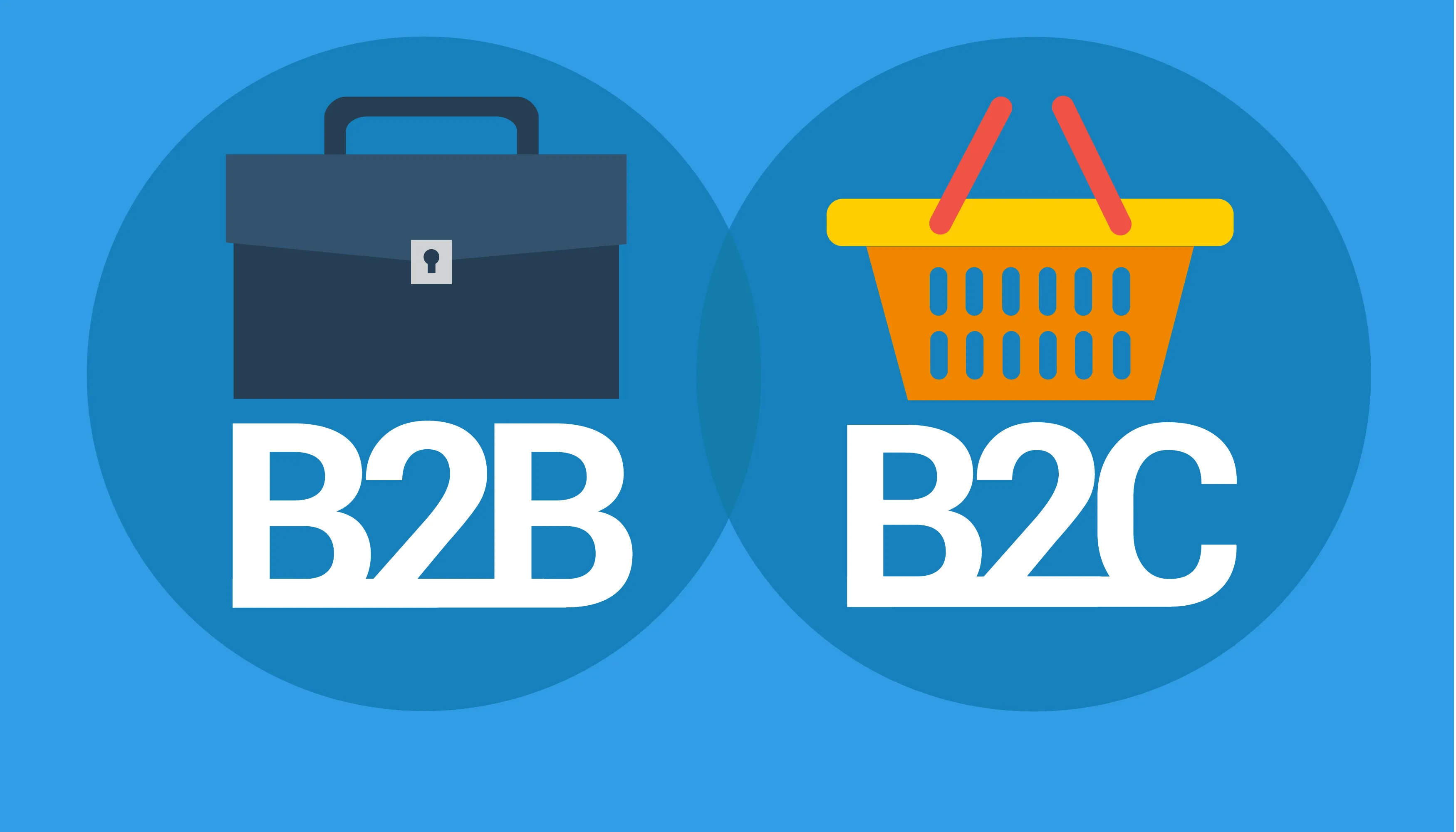
B2B Decision-making
Multi-layered and Rational: B2B purchasing decisions often involve multiple stakeholders, each with their own set of concerns and criteria. The process is inherently rational, focusing on the product's or service's return on investment (ROI), efficiency improvements, and long-term benefits for the organization.
- Example: When a business is considering a new software solution, it's not uncommon for IT, management, and end-users to have input into the decision. A comprehensive evaluation process, including demos, pilot programs, and ROI analyses, is typical.
- According to a Gartner study, buying groups for complex B2B solutions involve, on average, 6 to 10 decision-makers.
Longer Sales Cycles: The decision-making process in B2B is lengthier, given the higher stakes, larger financial commitments, and the need for consensus among decision-makers.
- Each stakeholder's needs and concerns must be addressed, requiring personalized marketing efforts and a consultative sales approach.
B2C Decision-making:
Emotionally Charged and Individual: B2C purchases are more likely to be driven by individual desires, emotional responses, and personal preferences. The decision-making process is quicker, often based on impulse or immediate need.
- Example: A consumer's decision to buy a new pair of shoes can be influenced by factors like brand loyalty, trendiness, or an emotional connection to an advertisement.
- Studies indicate that emotion drives most consumer purchases, with brands that engage customers on an emotional level seeing twice the impact on marketing effectiveness compared to those that don’t.
Simpler and Direct: With fewer steps from discovery to purchase, B2C decision-making is streamlined. Consumers often make decisions alone or with limited input from others, relying on straightforward information and how well a product or service resonates with their personal identity or needs.
- The immediacy of personal need and the availability of products make the B2C buying process more direct. Marketing strategies that highlight product benefits, special offers, and emotional appeals can effectively influence consumer decisions.
B2B vs B2C Marketing Strategy: Audience Targeting

Audience targeting in marketing strategies significantly diverges between B2B and B2C sectors, primarily due to the distinct nature of their markets and the specific needs of their audiences.
B2B Audience Targeting:
Niche and Focused: B2B marketing targets a smaller, more specific audience. The focus is on organizations, industries, or professionals that have a direct need for the product or service being offered.
- Example: A company selling enterprise-level cybersecurity software will target IT managers and CTOs in industries with high data security needs, such as finance and healthcare.
- LinkedIn reports that B2B marketers see a 2x higher engagement with personalized and industry-specific content.
Deep Understanding of Business Needs: Effective B2B audience targeting requires an in-depth understanding of the business challenges, industry trends, and operational needs of the potential clients.
- This understanding allows marketers to craft messages and content that speak directly to the pain points and aspirations of their target audience, enhancing the relevance and impact of their marketing efforts.
B2C Audience Targeting:
Broader and Diverse: B2C marketing often addresses a wider audience, catering to personal needs, interests, and lifestyles. The emphasis is on reaching individuals or groups based on demographic, psychographic, and behavioral criteria.
- Example: A fashion retailer might target young adults aged 18-30 interested in sustainable clothing, using social media trends and influencers to connect with this demographic.
- According to a survey by Statista, 90% of young adults (18-29 years old) use at least one social media site, highlighting the importance of these platforms in B2C audience targeting.
Emotional and Aspirational Messaging: B2C targeting leverages emotional resonance and aspirational messages to appeal to personal desires, creating a connection that motivates individual purchasing decisions.
- Emotional and aspirational appeals can effectively influence consumer behavior by tapping into the personal values and desires that drive spontaneous purchasing decisions.
B2B vs B2C Marketing Strategy: Ad Copy

Ad copy, the text used in advertising materials, plays a crucial role in the success of marketing campaigns, directly impacting audience engagement and conversion rates.
B2B Ad Copy:
Features and Benefits-Oriented: B2B ad copy tends to emphasize the features, benefits, and value propositions of the product or service. The focus is on how it can solve specific business problems or improve operational efficiency.
- An ad for a cloud-based project management tool might highlight its ability to streamline collaboration across global teams, reduce project delivery times, and increase ROI.
- A study by the Content Marketing Institute found that 71% of B2B buyers engage with content during the purchase process that speaks directly to their business needs.
Professional and Informative: The tone is more professional, often incorporating industry jargon and detailed information to communicate credibility and expertise. It's tailored to decision-makers seeking to make informed choices.
- B2B buyers require information that will help them justify the purchase within their organization. Detailed ad copy supports this need by providing tangible evidence of the product’s value.
B2C Ad Copy:
Emotional and Persuasive: B2C ad copy is crafted to evoke emotions and persuade the consumer on a personal level. It often uses storytelling, humor, or aspirational messages to create a connection with the audience.
- Example: A lifestyle brand might use ad copy that evokes a sense of adventure and freedom associated with its products, appealing to consumers' desires for self-expression.
- Emotions are the primary driver in 95% of consumer purchasing decisions, as reported by the Journal of Consumer Research.
Concise and Action-Oriented: B2C ads are typically shorter, using compelling calls-to-action (CTAs) to prompt immediate consumer response. The language is straightforward, focusing on the benefits that resonate on a personal level.
- Consumers are bombarded with advertising daily. Concise, action-oriented ad copy can capture attention and motivate quick decisions in a crowded marketplace.
Concluding Thoughts
To sum up the differences between B2B and B2C marketing strategies, it's all about who you're selling to and how you talk to them. For businesses selling to other businesses (B2B), it's about building trust and showing how your products can solve specific problems over time.
This means sharing detailed info and keeping in touch a lot. For businesses selling directly to people (B2C), it's more about making an instant connection, often using emotions or offers like financial incentives to get customers to buy quickly.
Whether it's a same company dealing with both B2B and B2C, they need to adjust their approach based on whether they're talking to a company or a person. Also, knowing that customers read online reviews before buying is crucial for both B2B and B2C strategies, showing the power of what others say about your products.

